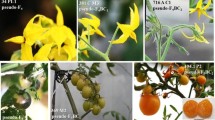Summary
Resistant plants and plants with reduced susceptibility against the pathogen Phoma lingam could be regenerated from selected callus and embryogenic cultures of haploid rape (Brassica napus) previously treated with mutagens. In the two in vitro selection systems used — absence of fungus growth on the cultures after incubation with parasite spores and resistance to the toxic filtrate — the resistance to the toxin was effective. In addition, some regenerants with increased tolerance were obtained from unselected cultures. Resistance tests on regenerated plants were carried out by inoculation of whole plants in the greenhouse, reproducing as much as possible the infection mechanisms which take place under natural conditions. Preliminary results on resistance of the progeny of single susceptible and tolerant regenerants seem to indicate that the acquired resistances are of a genetic nature.
Similar content being viewed by others
Literature
Behnke, M. (1979): Selection of potato callus for resistance to culture filtrates of Phytophthora infestans and regeneration of resistant plants. Theor. Appl. Genet. 55, 69–71
Behnke, M. (1980a): General resistance to late bligh of Solanum tuberosum plants regenerated from callus resistant to culture filtrates of Phytophthora infestans. Theor. Appl. Genet. 56, 151–152
Behnke, M. (1980b): Selection of dihaploid potato callus for resistance to the culture filtrate of Fusarium oxysporum. Z. Pflanzenzücht. 85, 254–258
Boudard, G. (1978): Phytotoxine et necrose des hypocotyles de crucifères infectées par Leptosphaeria maculans (Ces. et De Not) et sa forme imparfaite Phoma lingam. Phytopath. Z. 92, 76–82
Bousquet, J.-F.; Férézou, J.-P.; Devys, M.; Barbier, M. (1977): Sur une toxine produite par le Champignon Phoma lingam Tode, parasite du Colza; isolement et propriétés. C. R. Acad. Sc. Paris, Série D, 927–928
Brettel, R.I.S.; Goddard, B.V.D.; Ingram, D.S. (1979): Selection of Tms-cytoplasm maize tissue cultures resistant to Drechslera maydis T-toxin. Maydica 24, 203–213
Brettel, R.I.S.; Ingram, D.S. (1979): Tissue culture in the production of novel disease-resistant crop plants. Biol. Rev. 54, 329–345
Brettel, R.I.S.; Thomas, E. (1980): Reversion of Texas malesterile cytoplasm maize in culture to give fertile T-toxin resistant plants. Theor. Appl. Genet. 58, 55–58
Cargeeg, L.A.; Thurling, N. (1980): Contribution of hostpathogen interactions to the expression of the blackleg disease of spring rape (Brassica napus L.) caused by Leptosphaeria maculans (Desm.) Ces et De Not. Euphytica 29, 465–476
Carlson, P.S. (1973): Methionine-sulfoximine-resistant mutants of tobacco. Science 180, 1366–1368
Chaleff, R.S. (1981): Genetics of Higher Plants. Applications of Cell Culture. Cambridge: Univ. Press
Gamborg, O.L.; Miller, R.A.; Ojima, K. (1968): Nutrient requirements of suspension cultures of soybean root cells. Exp. Cell Res. 50, 151–158
Gegenbach, B.G.; Green, C.E.; Donovan, C.M. (1977): Inheritance of selected pathotoxin resistance in maize plants regenerated from cell cultures. Proc. Nat. Acad. Sci. USA 74, 5113–5117
Gegenbach, B.C.; Connelly, J.A.; Pring, D.R.; Conde, M.F. (1981): Mitochondrial DNA variation in maize plants regenerated during tissue culture selection. Theor. Appl. Genet. 59, 161–167
Heinz, D.J.; Krishnamurthi, M.; Nickel, L.G.; Maretzki, A. (1977): Cell, tissue and organ culture in sugarcane improvement. In: Applied and Fundamental Aspects of Plant Cell, Tissue, and Organ Culture (eds. Reinert, J.; Bajaj, Y.P.S.), pp. 3–17. Berlin, Heidelberg, New York: Springer
Helgeson, J.P.; Haberlach, G.T.; Upper, C.D. (1976): A dominant gene conferring disease resistance to tobacco plants is expressed in tissue cultures. Phytopathology 66, 91–96
International Atomic Energy Agency, Proceedings Series: Induced Mutations for Disease Resistance in Crop Plants, Vienna (1974); Induced Mutations Against Diseases, Vienna (1977)
McGee, D.C.; Petrie, G.A. (1978): Variability of Leptosphaeria maculans in relation to blackleg of oilseed rape. Phytopathology 68, 625–630
Matern, U.; Strobel, G.; Shepard, J. (1978): Reaction to phytotoxins in a potato population derived from mesophyll protoplasts. Proc. Nat. Acad. Sci. USA 75, 4935–4939
Melchers, G.; Bergmann, L. (1959): Untersuchungen an Kulturen von haploiden Geweben von Antirrhinum majus. Ber. Dt. Bot. Ges. 71, 459–473
Murashige, T.; Skoog, F. (1962): Revised media for rapid growth and bioassays with tobacco tissue culture. Physiol. Plantarum 15, 473–497
Nienhaus, F. (1969): Phytopathologisches Praktikum. Berlin, Hamburg: Parey
Sacristán, M.D. (1979): Attempts to obtain resistant plants against Plasmodiophora brassicae and Phoma lingam from selected tissue cultures of Brassica napus. In: Proc. Eucarpia “Cruciferae 1979” Converence (eds. von Marrewyk, N.P.A.; Toxopeus, H.), pp. 148–150. Wageningen: SVP, RIVRO
Sacristán, M.D. (1981): Regeneration of plants from longterm callus cultures of haploid Brassica napus. Z. Pflanzenzücht. 86, 248–253
Sacristán, M.D.; Hoffmann, F. (1979): Direct infection of embryogenic tissue cultures of haploid Brassica napus with resting spores of Plasmodiophora brassicae. Theor. Appl. Genet. 54, 129–132
Siegemund, F. (1981): Selektion von Resistenzmutanten in pflanzlichen Zellkulturen — eine Übersicht. Biol. Zbl. 100, 155–165
Thomas, E.; Wenzel, G. (1975): Embryogenesis from microspores of Brassica napus. Z. Pflanzenzücht. 74, 77–81
Thomas, E.; Hoffmann, F.; Potrykus, I.; Wenzel, G. (1976): Protoplast regeneration and stem embryogenesis of haploid androgenetic rape. Mol. Gen. Genet. 145, 245–247
Thomas, E.; King, P.J.; Potrykus, I. (1979): Improvement of crop plants via single cells in vitro — an assessment. Z. Pflanzenzücht. 82, 1–30
Williams, P.H.; Delwiche, P.A. (1979): Screening for resistance to blackleg of Crucifers in the seedling stage. In: Proc. Eucarpia “Cruciferae 1979” Conference (eds. von Marrewyk, N.P.A.; Toxopeus. H.), pp. 164–170. Wageningen: SVP, RIVRO
Author information
Authors and Affiliations
Additional information
Communicated by G. Melchers
Part of these results was reported in a scientific meeting („Die höhere Pflanzenzelle: Möglichkeiten und Grenzen der Forschung”) dedicated to Professor G. Melchers in the Max-Planck-Institut für Zellbiologie (Ladenburg) in January 1981
Rights and permissions
About this article
Cite this article
Sacristán, M.D. Resistance responses to Phoma lingam of plants regenerated from selected cell and embryogenic cultures of haploid Brassica napus . Theoret. Appl. Genetics 61, 193–200 (1982). https://doi.org/10.1007/BF00273774
Received:
Issue Date:
DOI: https://doi.org/10.1007/BF00273774




